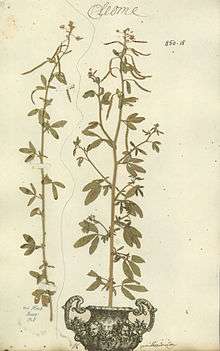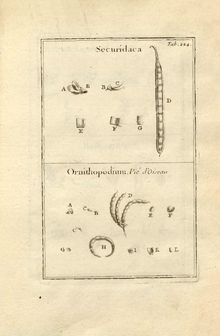Cleome ornithopodioides
Cleome ornithopodioides or bird spiderflower is the type species of the genus Cleome which is part of the family Cleomaceae or Brassicaceae. The species epithet means "birds-foot like" (ornithopodi + oides).[1][2]
| Cleome ornithopodioides | |
|---|---|
 | |
| bird spiderflower | |
| Scientific classification | |
| Kingdom: | Plantae |
| Clade: | Tracheophytes |
| Clade: | Angiosperms |
| Clade: | Eudicots |
| Clade: | Rosids |
| Order: | Brassicales |
| Family: | Cleomaceae |
| Genus: | Cleome |
| Species: | C. ornithopodioides |
| Binomial name | |
| Cleome ornithopodioides | |
Description
Cleome ornithopodioides is an annual plant growing to a height of .3 m.[3]
Flowers possess both male and female reproductive organs.[3]
Taxonomy

The first samples of bird spiderflower to arrive in Europe came from explorations of the area called Levant and were successfully cultivated by James Sherard in 1732.[4]
Joseph Pitton de Tournefort named the Claude Aubriet illustration of C. ornithopodioides Sinapistrum Orientale in the 1700 Institutiones rei herbariæ.[5] Being named before the 1753 Species plantarum disqualifies the name from being considered to be a synonym.[6]
When Carl Linnaeus first published this species with its current name in his 1753 Species plantarum[7] he referenced descriptions of Sinapistrum Ornithopodiisiliquis found in Johann Christian Buxbaum's herbarium Plantarum minus cognitarum centuria, that was published posthumously by Johann Georg Gmelin in 1728,[8] Johann Jacob Dillenius's 1732 Hortus Ethamensis.[9] a collection whose list was published in 1907 by George Claridge Druce[10] and also the description he wrote of Cleome ornithopodioides in his own Hortus Cliffortianus from 1737[11] and of Sinapestrum orientale triphyllum from his 1748 Hortus Upsaliensis.[12]
In 1754 when Philip Miller described the genus Sinapistrum in The Gardeners Dictionary, he described the species with English words "Three-leav'd Eastern Sinapistrum, with Birds-foot-pods" and called it by the Latin name Sinapistrum Oriental triphyllum as it had been assigned by Tournefort who had described it before him.[13]
- Taxonomy references
- International Association for Plant Taxonomy (March 2007). "ICBN: International Code of Botanical Nomenclature". Archived from the original on 2012-10-06. Retrieved 2009-04-30.
- Miller, F.R.S., Philip (1754). The Gardeners Dictionary Containing the Methods of Cultivating and Improving All Sorts of Trees, Plants, and Flowers, for the Kitchen, Fruit, and Pleasure Gardens; as Also Those which are used in Medicine. With Directions for the Culture of Vineyards, and Making of Wine, in England. In Which Likewise are Included the Practical Parts of Husbandry. In Three Volumes. Vol. III (Fourth ed.). London: Printed for the Author. Retrieved 2009-04-19.
- Linnæi, Caroli (1753). Species plantarum:exhibentes plantas rite cognitas, ad genera relatas, cum differentiis specificis, nominibus trivialibus, synonymis selectis, locis natalibus, secundum systema sexuale digestas. Tomus II. Holmiæ: Impensis Laurentii Salvii. ISBN 0-665-52874-4. Retrieved 2009-04-24.
- Linnæi, Caroli (1737). Hortus Cliffortianus Plantas exhibens Quas In Hortistam Vivis quam Siccis, Hartecampi in Hollandia. Clifford, Georgius. Amstelaedami. Retrieved 2009-04-24.
- Linnæi, Caroli (1748). Hortus Upsaliensis, Exhibens Plantas Exoticas, Horto Upsaliensis Academiæ A Sese Illatas, Ab anno 1742, in annum 1748, Additis Differentiis, Synonymis, Habitationibus, Hospitiis, Rariorumque Descriptionibus, In Gratiam, Studiofæ juventutis. Vol. I. Stockholmiæ: Sumtu & literis Laurentii Salvii. Retrieved 2009-04-30.
- Dillenius, Johann Jacob (1732). Hortus Ethamensis. Oxford University. p. 359, Tab 266.
- Buxbaum, Acad. Scient. Socium., J. C. (1728). Plantarum Minus Cognitarum Centuria compectens Plantas circa Byzantium & in Oriental Observatas. Volume I. Petropolis.
- Tournefort, Joseph Pitton de; Aubriet, Claude (1700). Corollarium Institutiones Rei Herbariæ in Quo. Tomus Primus. Paris: Typographia Regia. Retrieved 2009-04-25.
Ecology
Native to the area of the eastern Mediterranean,[4] C. ornithopodioides was described in 1865 as living in the wild along with Trifolium stellatum in a fertile valley at the foot of Mount Serbal.[14]
Cultivation
Philip Miller wrote of the ease of cultivation of C. ornithopodioides in his 1754 The Gardeners Dictionary: "...will thrive in open Air; so the Seeds of this may be sown on a Bed of light Earth in April (late Spring), where the Plants are to remain; and will require no other Culture, but to keep them clear from Weeds: in June (early Summer) they will flower, and the Seeds will ripen in August (late Summer); and the Plants will soon after perish."[15]
References
- "Linnaean Name:Cleome ornithopodioides Linnaeus". The Linnaean Plant Name Typification Project. London: The Natural History Museum. July 2006. Retrieved 2009-04-17.
- Griffith, Chuck (December 2005). "Dictionary of Botanical Epithets". Minneapolis. Retrieved 2009-05-02.
- "Cleome ornithopodioides". Plants For A Future. 1997–2000. Retrieved 2009-05-01.
- Druce, G. Claridge; Dillenius, Johann Jacob (1907). Vines, M.A., S.H. (ed.). The Dillenian Herbraria, An Account of the Dillenian Collections in the Herbarium of the University of Oxford Together With a Biographical Sketch of Dillenius, Selections from his Correspondence, Notes, &c. Oxford: Clarendon Press. Retrieved 2009-04-25.
- Brewer, Rev. E. Cobham (1877). Ebenezer Cobham Brewer. Volume II. London: William Tegg and Co. ISBN 1-85326-300-1. Retrieved 2009-05-02.
- Redhead, Esq., F.L.S. & R.G.S., Richard Milne (1867). "Notes on the Flora of the Desert of Sinai". Botanical Journal of the Linnean Society. London: Longmans, Green, Reader, and Dyer, and Williams and Norgate. IX: 208–229. doi:10.1111/j.1095-8339.1866.tb01279.x. Retrieved 2009-05-01.CS1 maint: multiple names: authors list (link)
- Aiton, Gardener to his Majesty, William Townsend (1812). Hortus Kewensis; or, A Catalogue of the Plants Cultivated in the Royal Botanic Garden at Kew, by the Late William Aiton. Vol. IV (2 ed.). London: Longman, Hurst, Rees, Orme, and Brown. Retrieved 2009-04-25.
Notes
- Dictionary of Botanical Epithets, orientalis - ovinus
- Errors of speech and of spelling, page 283
- Plants For A Future, C. ornithopodioides
- Hortus Kewensis (1812), page 132
- Institutiones rei herbariæ (1700), page 17
- IAPT, Important dates
- Species plantarum (1753), page 672
- Plantarum minus cognitarum centuria (1740), page 6
- Hortus Ethamensis (1732) p. 359, Tab 266
- The Dillenian Herbraria (1907), page 179
- Hortus Cliffortianus (1737), page 341
- Hortus Upsaliensis (1748) page 194
- The Gardeners Dictionary (1754), page 46
- Linnean Society (1867), page 215
- The Gardeners Dictionary (1754), page 46-47
External links
![]()
- Porter, Noah, ed. (1913). "Webster's entry needed". Webster's Dictionary. Springfield, Massachusetts: C. & G. Merriam Co.